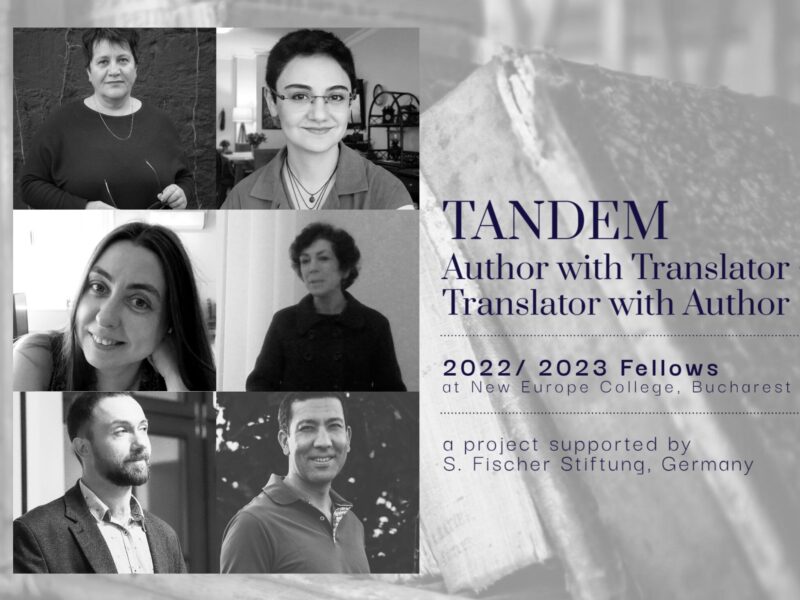Eliza Dumitrascu is a PR Manager within the ART Editorial Group. She’s been working in communication for years, putting her imagination and skill to work to promote cultural events and products. She collaborated with BeWheremagazine, with Revolver, a media company, with the Paralela 45 Publishing House and, for five years, after a short break, she helps the books published by the imprints of the ART Editorial Group to find their matching readers. Or vice versa. She has a yellow Coraline jacket, is a founding member of an exclusive knitting club and one of the most ardent supporters of one of the youngest insect collectors in our country.
What does a PR Manager generally do and how do they start their working day?
They start their day with a strong coffee and then talk to a lot of people.
You’ve worked in publishing houses (Paralela 45 and Art), in a company that organizes cultural events and for a magazine. The artistic part was always there, but the raw material was different. Is it harder to sell books than magazines? What about magazines versus concerts?
All of them are difficult to sell because we’re talking about cultural products, but some may be easier to sell than others when the brand you work for is an authoritative one. I know that I was pleasantly surprised when I was greeted with great warmth in the editorial office of an important radio station just because I was communicating for the The Museum of the Romanian Peasant, which has always been perceived as a very cool museum. This is the case with many of the projects of the ART Editorial Group, the association is very desirable and this helps you take part in many great projects, it brings you in contexts where you may, with your own means, fail to reach. And exposure helps you gain notoriety, but also sell. In our experience, the purchase decision comes after three or four interactions with the product, so the more often the readers see you, in more contexts, the more motivated they are to buy from you.
Is there a course of the book in the PR department? Is there a pattern that you apply to all books?
We mostly work according to a plan, this way we make sure that each title benefits from visibility on all our promotion channels: website, social media, newsletter, partners. Once the cover is finalized and the price is set, the book enters a rather technical promotion circuit. Each new title is available for pre-order on average about two weeks, i.e. it has a lower price and is somehow in the spotlight (banners, photos, reviews, previews, contests etc.). Reprints are included in list-type articles, which we publish monthly on the publisher's blogs and in other commercial offers. And there are the star books or the locomotive books (depending on whether you look at it from the angle of the PR person or the sales person) for which larger campaigns are designed. These are the ones we like the most, but unfortunately it’s impossible to be overly creative when you have to manage a portfolio of over 1000 titles.

What campaign are you most proud of? What about the one that was an epic fail?
The funniest thing was when a colleague, returning from an edition of the Frankfurt Book Fair, brought us in the department several promotional materials: leaflets, bookmarks, a very chic fan and, among them, and a trivial yellow cardboard crown. Of all of them, we said let's try our luck with the crown and we made a similar stamp, in blue, with the message "Arthur 10 years", because that was what we were going to communicate at Gaudeamus 2018. And it was insane. Their success took us by surprise, we couldn’t even assemble them in the rhythm in which they were running out. The whole team wore wreaths worn by both children (regardless of age) and their parents or grandparents. We arrived at the fair an hour earlier to cover the whole stand with wreaths. And people came as under a spell. Some asked us to offer them unassembled crowns for the children at home or some teachers asked us for entire classes. Everyone was amused by these funny objects that filled the whole fair with Arthur's message for five days.
Next year we tried to replace the crowns with helmets, which were much harder to assemble and were not as successful.
When can one assert that a marketing or communication idea was good? How do you quantify the success in this area?
When the product or the message or what we’re thinking of offering to the public is something extremely desirable. Our communication priorities do not always correspond to the wishes of our readers. And because we address such a small audience, it would be ideal to always have an original idea or to use the old ones as rarely as possible.
And can this idea be replicated?
Rather not.
Have you ever felt that you’ve managed to make a book sell over its value through your efforts?
Literary value or investment value? Mainly, at the ART Editorial Group we publish valuable books both in terms of content and as a product. Referring to the costs of publication, well, they pay off in several years, so the critical period is the first six months after the launch, the maximum period in which a book is considered a novelty. If we fail to produce enough buzz (default sales) in these first six months, over time it becomes increasingly difficult to maintain interest in a title / author. And I don't know if there was a book or a marketing campaign on our market that would’ve covered all the costs in this time frame. As for me, the answer to your question is no.
You have many international celebrity writers in your portfolio, who come with whole carts of campaigns and marketing materials. Have you used in promotion any ideas already proven abroad? Does this transshipment work?
We study marketing kits received from abroad with great interest, they really reflect serious industries, and even if not all proposals have applicability in Romania, because some involve very large budgets, we try to reproduce some topics that we think they would enjoy on readers. For example, anniversary marketing campaigns (Roald Dahl Roald Dahl, Harry Potter Book Nigh etc.) help a lot to promote the titles in the backlist, even if we don't always have a new release. Then, auxiliary materials of all kinds (activity sheets, posters, calendars etc.) that help children connect to the universe of the story and that can be solved at home, in the family, or even at school, are appreciated by both children, as well as their trainers. Consumption of video / audio content increased during this period when we all - children and parents - surfed the Internet a lot. I received videos from foreign authors and even internally produced a lot of content like this; the first example that comes to mind is Arthuroteca (our children's book reading project). In our experience, any type of content associated with a book increases the sales potential in the most concrete way possible.
I was talking to the Romanian writers interviewed here about the involvement in promoting their books and about how some would prefer to take their hand off the book once it’s handed over to the publishing house, to let it on its way. Did you happen to come across any of these writers? How do you get their hands on the book and persuade them to get involved in promoting it?
I think the wisest thing is to be patient until we find out what makes that author feel at ease. Some are excellent public speakers, others feel comfortable giving written interviews, and others manage their relationship with readers very well through social media. Every writer, I think, will inevitably end up talking about their book if the right context is created.
An ongoing campaign is Dear Writer, through which all children who have read a Romanian author published by Arthur are invited to compose, write by hand and send in an envelope a letter addressed to an author. We are in the third week of the campaign and we have already received over fifty letters from all over the country. Even though there were reservations about getting involved in this campaign, the children's questions, curiosities and advice had the gift of creating a bridge of communication with even the most discreet / restrained authors. We invite you to follow them because we publish them weekly on the his Blog.

When you say book launch, you invariably think of a table with 3-5 people talking and that`s all folks. And the voices from off call for unconventional events. But what does unconventional PR mean? Is the book market ready for such a thing?
Fortunately, I was lucky enough to work with someone brave enough to practice PR out of the box since the publishing house was launched. In 2007, when the first efforts were made for the visual identity of the ART Publishing House, Laura Albulescu had the brilliant idea to bargain with someone to fill the center of Bucharest with yellow paint stencils representing the logo of the publishing house. Out of excessive zeal, our graffiti artist applied one on the foundation of the Cărturești Verona bookstore, a fact that was not looked upon favorably by our partner. Informal, of course. Then many other projects of the same caliber followed: the launch of the volume Lipscani. Tourist and Party Guide by Eugen Istodor was accompanied by Balkan music, the collective project Santa Claus & Co. The Fastest Novel in the World was listed in the Guinness Book on December 15, 2010, the launch of the audiobook project on vinyl - audioART from Club Control in 2018. I strongly believe that the public would breathe a sigh of relief if literary events happened the opposite of how you described them..
What promotion channels work best for you now?
The only known efforts are the online ones where budgets are allocated, and the effects are immediately visible. Given that we’ve been living inside our homes for a year and a half, unfortunately, almost any other form of communication has atrophied or disappeared.
Does the old "from mouth to mouth" still has a place among all this?
It will never go out of style.:)
An old saying goes that Facebook is for boomers, Instagram is for young people and Tik Tok is for our descendants. How do you promote in an online where the platforms change from month to month, and the display algorithms faster than I could write this question?
Publishers strive to build communities around brands and to be connected, at least virtually, with readers. The ART Editorial Group also manages many Facebook and Instagram accounts, there is one for each imprint, even for some of the newer projects such as musai or Sapiens (collections of ART Publishing), or for the special projects we carry out to Arthur, and I'm thinking of the Order of Storytellersmagazine. We try to be as present as possible on social media, where the readers are, even if sometimes one step behind them, and it’s a strenuous effort to try to beat the display algorithms; it would basically mean doing this all day. Fortunately, at the ART Editorial Group we are endowed with a leprechaun who has a very good understanding of SEO, Data Analytics, search engines and who helps us to channel our efforts in the right direction for the company (too).

How many free books do you have to give to influencers, media people and other promoters to sell a title and cover the costs?
Unfortunately, influencers read for money (many), people in the press allocate very little space to cultural news, we are left with professional readers - who are neither influencers nor media people - and who promote books from passion on blogs or social media accounts. Our policy is to send them just about anything they want, out of conviction that they will write good reviews about the books they’ve been waiting to see / browse / read. We don't go on imposed campaigns, because that doesn't work. And we also had pleasant surprises to offer to send books to important people, with authority in the field, who politely refused under the pretext of preferring to discover them in bookstores. The number of copies varies from title to title, but let's say we ship a significant number of books each month.
Is the cultural PR a geographically sensitive field? How do you promote a book in a small / medium provincial town? Is everything exclusively online?
If the city is lucky enough to have a bookstore, there is a chance to display messages in the shop window or on the shelf. However, for reasons that are easy to understand (lack of space, sales orientation etc.) the messages in bookstores are mostly commercial. We can rarely afford to waste these communication opportunities with such specialized messages, such as promoting a single title. In the online environment, we compensate through partnerships with many passionate people from all over the country.
Are you involved in decisions to purchase a new title or author? Does the communications team have a say in this decision?
Fortunately, not.

How important are the studies finished in this field or how much is it related to the gained experience?
(Communication) studies contribute to the clear and concise wording of a text, help you get rid of the ballast of words you are tempted to add to the message, and experience brings context and adequacy. There are voices that claim that the fault of the book industry is our belief that the product we sell is atypical, hence the somewhat more precious communication, let's say. But there are many things to keep in mind when promoting a book, to find that balance between something that doesn’t offend the reader's intelligence, but does not discourage a potential customer. I think experience can help you maintain that balance. Like when a parent approaches you with the question: what do you recommend for a 10-year-old boy who doesn't read much? At that moment all the responsibility is yours; I'm exaggerating a bit, but what do you do if your choice is decisive for the reading destiny of the 10-year-old boy you've never seen?
And what does this experience actually mean? What does it translate into?
As I said above.
If you were to knit a periodic table, but instead of chemical elements to be the covers of the books that made you hold your breath for at least a few seconds, which would be among the noble gases?
Because you alluded to Primo Levi 's masterpiece, I would also like to recommend Is this a man?and then these come to mind: The Savage by Guillermo Arriaga, The Sympathizer by Viet Thanh Nguyen, Woman at 1,000 Degrees by Hallgrímur Helgason and One of Us by journalist Åsne Seierstad.
[Photos are part of Eliza Dumitrașcu's archive.] [Translated into English by Silvia Codescu.]




